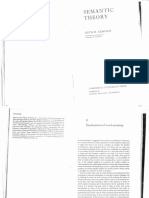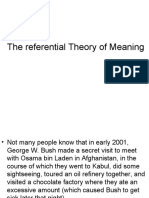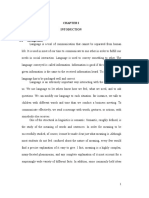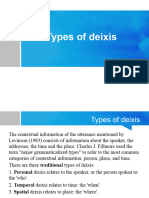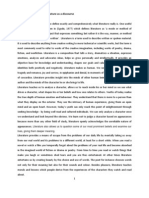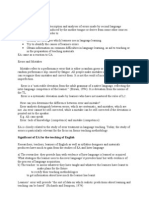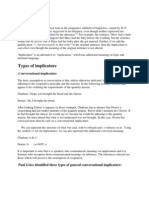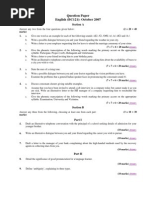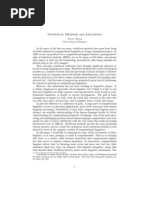Ambiguities Around Us
Ambiguities Around Us
Uploaded by
Tan Hiau MianCopyright:
Available Formats
Ambiguities Around Us
Ambiguities Around Us
Uploaded by
Tan Hiau MianOriginal Description:
Original Title
Copyright
Available Formats
Share this document
Did you find this document useful?
Is this content inappropriate?
Copyright:
Available Formats
Ambiguities Around Us
Ambiguities Around Us
Uploaded by
Tan Hiau MianCopyright:
Available Formats
AMBIGUITIES AROUND US
A word, phrase, or sentence is ambiguous if it has more than one meaning. The word
'light', for example, can mean not very heavy or not very dark. Words like 'light', 'note',
'bear' and 'over' are lexically ambiguous. They induce ambiguity in phrases or
sentences in which they occur, such as 'light suit' and 'The duchess can't bear
children'. However, phrases and sentences can be ambiguous even if none of their
constituents is. The phrase 'porcelain egg container' is structurally ambiguous, as is
the sentence 'The police shot the rioters with guns'. Ambiguity can have both a
lexical and a structural basis, as with sentences like 'I left her behind for you' and 'He
saw her duck'.
The notion of ambiguity has philosophical applications. For example, identifying an
ambiguity can aid in solving a philosophical problem. Suppose one wonders how two
people can have the same idea, say of a unicorn. This can seem puzzling until one
distinguishes 'idea' in the sense of a particular psychological occurrence, a mental
representation, from 'idea' in the sense of an abstract, shareable concept. On the
other hand, gratuitous claims of ambiguity can make for overly simple solutions.
Accordingly, the question arises of how genuine ambiguities can be distinguished
from spurious ones. Part of the answer consists in identifying phenomena with which
ambiguity may be confused, such as vagueness, unclarity, inexplicitness and
indexicality.
Although people are sometimes said to be ambiguous in how they use language,
ambiguity is, strictly speaking, a property of linguistic expressions. A word, phrase, or
sentence is ambiguous if it has more than one meaning. Obviously this definition
does not say what meanings are or what it is for an expression to have one (or more
than one). For a particular language, this information is provided by a grammar,
which systematically pairs forms with meanings, ambiguous forms with more than
one meaning (see MEANING and SEMANTICS).
There are two types of ambiguity, 1. lexical 2.structural.
Lexical ambiguity is ambiguity based on a single word. In many cases, a single
word in a language corresponds to more than one thought, for example, the
adjective light (not dark vs. not heavy); the noun bank (financial institution vs. the
edge of a river); and the verb run (to move fast vs. to direct or manage). Words may
also have more than one meaning through their unrelated use in more than one
category of speech, for example,can (a container of food noun vs. to be able to
verb).
Inattentive use of ambiguous words can lead to humorous, or even awkward
situations, as shown by these newspaper headlines collected by Stephen Pinker.
Iraqi Head Seeks Arms
Childs Stool Great for Use in Garden
Stud Tires Out
Stiff Opposition Expected to Casketless Funeral Plan
Drunk Gets Nine Months in Violin Case
Lexical ambiguity is by far the more common. Everyday examples include nouns like
'chip', 'pen' and 'suit', verbs like 'call', 'draw' and 'run', and adjectives like 'deep', 'dry'
and 'hard'. There are various tests for ambiguity. One test is having two unrelated
antonyms, as with 'hard', which has both 'soft' and 'easy' as opposites. Another is the
conjunction reduction test. Consider the sentence, 'The tailor pressed one suit in his
shop and one in the municipal court'. Evidence that the word 'suit' (not to mention
'press') is ambiguous is provided by the anomaly of the 'crossed interpretation' of the
sentence, on which 'suit' is used to refer to an article of clothing and 'one' to a legal
action.
The above examples of ambiguity are each a case of one word with more than one
meaning. However, it is not always clear when we have only one word. The verb
'desert' and the noun 'dessert', which sound the same but are spelled differently,
count as distinct words (they are homonyms). So do the noun 'bear' and the verb
'bear', even though they not only sound the same but are spelled the same. These
examples may be clear cases of homonymy, but what about the noun 'respect' and
the verb 'respect' or the preposition 'over' and the adjective 'over'? Are the members
of these pairs homonyms or different forms of the same word? There is no general
consensus on how to draw the line between cases of one ambiguous word and
cases of two homonyous words. Perhaps the difference is ultimately arbitrary.
Sometimes one meaning of a word is derived from another. For example, the
cognitive sense of 'see' seems derived from its visual sense. The sense of 'weigh' in
'He weighed the package' is derived from its sense in 'The package weighed two
pounds'. Similarly, the transitive senses of 'burn', 'fly' and 'walk' are derived from their
intransitive senses. Now it could be argued that in each of these cases the derived
sense does not really qualify as a second meaning of the word but is actually the
result of a lexical operation on the underived sense. This argument is plausible to the
extent that the phenomenon is systematic and general, rather than peculiar to
particular words. Lexical semantics has the task of identifying and characterizing
such systematic phemena. It is also concerned to explain the rich and subtle
semantic behavior of common and highly flexible words like the verbs 'do' and 'put'
and the prepositions 'at', 'in' and 'to'. Each of these words has uses which are so
numerous yet so closely related that they are often described as 'polysemous' rather
than ambiguous.
Beside of the above, lexical ambiguity can also lead to humorous sentences, for
example, the following collected from newspapers by Stephen Pinker.
oko Ono will talk about her husband John Lennon who was killed in an
interview with Barbara Walters.
Two cars were reported stolen by the Groveton police yesterday.
No one was injured in the blast, which was attributed to a buildup of gas
by one town official.
Structural ambiguity occurs when a phrase or sentence has more than one
underlying structure, such as the phrases 'Tibetan history teacher', 'a student of high
moral principles' and 'short men and women', and the sentences 'The girl hit the boy
with a book' and 'Visiting relatives can be boring'. These ambiguities are said to be
structural because each such phrase can be represented in two structurally different
ways, e.g., '[Tibetan history] teacher' and 'Tibetan [history teacher]'. Indeed, the
existence of such ambiguities provides strong evidence for a level of underlying
syntactic structure (see SYNTAX). Consider the structurally ambiguous sentence,
'The chicken is ready to eat', which could be used to describe either a hungry chicken
or a broiled chicken. It is arguable that the operative reading depends on whether or
not the implicit subject of the infinitive clause 'to eat' is tied anaphorically to the
subject ('the chicken') of the main clause.
It is not always clear when we have a case of structural ambiguity. Consider, for
example, the elliptical sentence, 'Perot knows a richer man than Trump'. It has two
meanings, that Perot knows a man who is richer than Trump and that Perot knows
man who is richer than any man Trump knows, and is therefore ambiguous. But what
about the sentence 'John loves his mother and so does Bill'? It can be used to say
either that John loves John's mother and Bill loves Bill's mother or that John loves
John's mother and Bill loves John's mother. But is it really ambiguous? One might
argue that the clause 'so does Bill' is unambiguous and may be read unequivocally
as saying in the context that Bill does the same thing that John does, and although
there are two different possibilities for what counts as doing the same thing, these
alternatives are not fixed semantically. Hence the ambiguity is merely apparent and
better described as semantic underdetermination.
Although ambiguity is fundamentally a property of linguistic expressions, people are
also said to be ambiguous on occasion in how they use language. This can occur if,
even when their words are unambiguous, their words do not make what they mean
uniquely determinable. Strictly speaking, however, ambiguity is a semantic
phenomenon, involving linguistic meaning rather than speaker meaning
(see MEANING AND COMMUNICATION);'pragmatic ambiguity' is an oxymoron.
Generally when one uses ambiguous words or sentences, one does not consciously
entertain their unintended meanings, although there is psycholinguistic evidence that
when one hears ambiguous words one momentarily accesses and then rules out
their irrelevant senses. When people use ambiguous language, generally its
ambiguity is not intended. Occasionally, however, ambiguity is deliberate, as with an
utterance of 'I'd like to see more of you' when intended to be taken in more than one
way in the very same context of utterance.
As a conclusion, Language cannot exist without ambiguity; which has represented
both a curse and a blessing through the ages. Since there is no one "truth" and no
absolutes, we can only rely on relative truths arising from groups of people who,
within their particular cultural systems, attempt to answer their own questions and
meet their needs for survival. Language is also a very complex phenomenon.
Meanings that can be taken for granted are in fact only the tip of a huge iceberg.
Psychological, social and cultural events provide a moving ground on which those
meanings take root and expand their branches.
You might also like
- Group 4 - Solidarity and PolitenessDocument15 pagesGroup 4 - Solidarity and Politenessani100% (1)
- Bacala Vs Heirs of Poliño G.R. No. 200608, (February 10, 2021)Document11 pagesBacala Vs Heirs of Poliño G.R. No. 200608, (February 10, 2021)RLAMMNo ratings yet
- Semantic Theory PDFDocument8 pagesSemantic Theory PDFHugo MartinezNo ratings yet
- Exercise Sheet AmbiguityDocument2 pagesExercise Sheet Ambiguityluonghanhngan0% (1)
- 2.1 Formal and Contextual LinksDocument5 pages2.1 Formal and Contextual LinksM Ans AliNo ratings yet
- Linguistic modality in Shakespeare Troilus and Cressida: A casa studyFrom EverandLinguistic modality in Shakespeare Troilus and Cressida: A casa studyNo ratings yet
- (Semantic) - Word, Meaning and ConceptDocument13 pages(Semantic) - Word, Meaning and ConceptIan NugrahaNo ratings yet
- STYLISTICS: Related Discipline: Phonology - Is The Study of The Patterns of Sounds in A Language and Across LanguagesDocument6 pagesSTYLISTICS: Related Discipline: Phonology - Is The Study of The Patterns of Sounds in A Language and Across LanguagesaninO9100% (1)
- The Referential Theory of MeaningDocument9 pagesThe Referential Theory of MeaningMaida Khan100% (1)
- Lexical Semantics 5Document38 pagesLexical Semantics 5negrutzzz100% (1)
- Hafta 12Document14 pagesHafta 12Md Ismail JanNo ratings yet
- On Attributive and Referential UseDocument27 pagesOn Attributive and Referential UseRichard RodríguezNo ratings yet
- Structural Ambiguity of EnglishDocument18 pagesStructural Ambiguity of EnglishthereereNo ratings yet
- HOMOPHONESDocument2 pagesHOMOPHONESKUAH PEI YAN IPG-PelajarNo ratings yet
- Stylistics GRP 2.pdf - 20231204 - 213200 - 0000Document31 pagesStylistics GRP 2.pdf - 20231204 - 213200 - 0000Ammi KhanNo ratings yet
- Slips of The EarDocument9 pagesSlips of The EarMichael SmithNo ratings yet
- NDocument29 pagesNNaya BolaNo ratings yet
- Yule Chapter 19 NotesDocument4 pagesYule Chapter 19 Notestsm hashinshinNo ratings yet
- Feaatures of Pakistani EnglishDocument7 pagesFeaatures of Pakistani EnglishTaimoor KhanNo ratings yet
- Pragmatic Analysis of Interrogtive Speech Act Inas SaffatDocument16 pagesPragmatic Analysis of Interrogtive Speech Act Inas SaffatAdel AhmedNo ratings yet
- Exocentric Compounds in AkanDocument40 pagesExocentric Compounds in AkanGabija PaškevičiūtėNo ratings yet
- 6 - Sentential SemanticsDocument5 pages6 - Sentential Semanticshajira.sair100% (1)
- BS (English) Dept of English University of SargodhaDocument36 pagesBS (English) Dept of English University of SargodhaFEROZ KHANNo ratings yet
- Rhetorical Structure TheoryDocument4 pagesRhetorical Structure TheoryMariam mNo ratings yet
- Language Production: Presented by Muhammad Saleem & Abid Hussain Assigned by Ma'Am SanaDocument20 pagesLanguage Production: Presented by Muhammad Saleem & Abid Hussain Assigned by Ma'Am SanaBaloch Karawan100% (1)
- Thematic RolesDocument8 pagesThematic RolesCrosslinguisticNo ratings yet
- Levels of Stylistic Analysis-1Document9 pagesLevels of Stylistic Analysis-1Eman KhurramNo ratings yet
- Componential Analysis + ExercisesDocument3 pagesComponential Analysis + ExercisesLy KhánhNo ratings yet
- Types of TranslationDocument16 pagesTypes of TranslationSaachi GroverNo ratings yet
- Things With Words (1962) and Further Developed by American Philosopher J.R. SearleDocument3 pagesThings With Words (1962) and Further Developed by American Philosopher J.R. SearleDDNo ratings yet
- Levels of Stylistic AnalysisDocument23 pagesLevels of Stylistic AnalysisEman KhurramNo ratings yet
- Exophora, Endophora, SubstitutionDocument21 pagesExophora, Endophora, Substitutionmythuan2709100% (2)
- London School of LinguisticsDocument15 pagesLondon School of LinguisticsJamiNo ratings yet
- Theories of MeaningDocument5 pagesTheories of MeaningAtif HayatNo ratings yet
- 1 Semantic FeaturesDocument3 pages1 Semantic FeaturesKaren HernandezNo ratings yet
- An Introduction To Relevance-Theoretic PragmaticsDocument15 pagesAn Introduction To Relevance-Theoretic PragmaticsLuqman AhsanulNo ratings yet
- Communication Accommodation TheoryDocument10 pagesCommunication Accommodation TheoryIsrar KhanNo ratings yet
- Lakoff (1973) : P's and Q's of PolitenessDocument4 pagesLakoff (1973) : P's and Q's of PolitenessHajra QayumNo ratings yet
- Sociolinguistics - Language and CultureDocument3 pagesSociolinguistics - Language and Culturenanda indiraNo ratings yet
- The Sun Rising Bay John Donne - Poem Guide - Learning Lab - The Poetry FoundationDocument4 pagesThe Sun Rising Bay John Donne - Poem Guide - Learning Lab - The Poetry FoundationMaruf HossainNo ratings yet
- 304 B (Except Iain Chambers & Shantha Ramakrishnan)Document24 pages304 B (Except Iain Chambers & Shantha Ramakrishnan)Ayushi S.100% (1)
- Introduction..Polysemy and HomonymyDocument6 pagesIntroduction..Polysemy and HomonymyClaudia Elena NegurăNo ratings yet
- Discourse and PowerDocument12 pagesDiscourse and PowerJohn Paul AdlawanNo ratings yet
- Summary of Chapter 3 G H Widdowson BookDocument4 pagesSummary of Chapter 3 G H Widdowson Booksuper boyNo ratings yet
- Structural AmbiguityDocument7 pagesStructural AmbiguityHazel HeeuiNo ratings yet
- An Assignment of Applied LinguisticsDocument4 pagesAn Assignment of Applied Linguisticsظہیر عباسNo ratings yet
- Equivalence Nida1Document22 pagesEquivalence Nida1kontal kantulNo ratings yet
- Translation ShiftsDocument7 pagesTranslation ShiftsAdam LassNo ratings yet
- Knowledge in DiscourseDocument7 pagesKnowledge in DiscoursevuphuonglinhNo ratings yet
- Types of ForegroundingDocument38 pagesTypes of ForegroundingAmnah ZafarNo ratings yet
- Corpus Stylistic: Presented By: Quissa Marie M. Gonzales-BSED Presented To: Dr. Arjan EspirituDocument16 pagesCorpus Stylistic: Presented By: Quissa Marie M. Gonzales-BSED Presented To: Dr. Arjan EspirituQuissa GonzalesNo ratings yet
- Chapter - Grammatical Analysis of DiscourseDocument2 pagesChapter - Grammatical Analysis of Discourseaijazahmed1w1100% (1)
- Introduction To Discourse AnalysisDocument33 pagesIntroduction To Discourse AnalysisbenatianihelNo ratings yet
- Ferdinand de SaussureDocument28 pagesFerdinand de SaussureRo Lu0% (1)
- SEMANTICSDocument46 pagesSEMANTICSKalima GaniNo ratings yet
- Types of DeixisDocument16 pagesTypes of DeixisМарина Ветер100% (1)
- Syntax Notes-1-ConstituentsDocument5 pagesSyntax Notes-1-ConstituentsMainul AlamNo ratings yet
- Literature As A DiscourseDocument8 pagesLiterature As A DiscourseGeorge AtaherNo ratings yet
- Error AnalysisDocument3 pagesError AnalysisMeryem Amy LeeNo ratings yet
- Analysis of Ant Hills of SavannahDocument12 pagesAnalysis of Ant Hills of SavannahKampo AkhangNo ratings yet
- ImplicatureDocument5 pagesImplicatureAjit ChaudhariNo ratings yet
- Hypnotic Language PDFDocument8 pagesHypnotic Language PDFRajesh100% (1)
- English 1007Document15 pagesEnglish 1007api-3815319No ratings yet
- Ambiguity PamelaDocument3 pagesAmbiguity Pamelabyron_castro_22No ratings yet
- WGK01 01 Pef 20180815Document29 pagesWGK01 01 Pef 20180815RafaNo ratings yet
- What Is Precision Writing?Document17 pagesWhat Is Precision Writing?SchniffyNo ratings yet
- 02 Inoculations The Masques of John HejdukDocument15 pages02 Inoculations The Masques of John HejdukFrancisco José LlinaresNo ratings yet
- Complexity and Contradiction in ArchitectureDocument10 pagesComplexity and Contradiction in ArchitectureUbaid KhanNo ratings yet
- LAW 521 LEGAL DRAFTING and CONVEYANCING Post Editorial Correction For UploadDocument170 pagesLAW 521 LEGAL DRAFTING and CONVEYANCING Post Editorial Correction For UploadVobogure SohagNo ratings yet
- Film Art, Argument, and Ambiguity.Document11 pagesFilm Art, Argument, and Ambiguity.Nelson VásquezNo ratings yet
- English10 Q2 Mod3 FormulatingAStatmentOfOpinionOrAssertion V4Document19 pagesEnglish10 Q2 Mod3 FormulatingAStatmentOfOpinionOrAssertion V4Lhea DolusanNo ratings yet
- Pioneer Insurance and Surety Corporation vs. APL Co. Pte.Document11 pagesPioneer Insurance and Surety Corporation vs. APL Co. Pte.EnzoNo ratings yet
- Purposive CommunicationDocument3 pagesPurposive CommunicationFaye MacalinaoNo ratings yet
- Statistical Methods and LinguisticsDocument23 pagesStatistical Methods and Linguisticsphilos33No ratings yet
- 4AA1 IG Arabic Grade DescriptorDocument5 pages4AA1 IG Arabic Grade DescriptorMohammedNo ratings yet
- #AE14 Ujian Betul Salah - Test True FalseDocument18 pages#AE14 Ujian Betul Salah - Test True FalseSiti HafidahNo ratings yet
- Chen & Zhang Eds, Machine Translation. 14th China Workshop 2018 (Springer 2019)Document136 pagesChen & Zhang Eds, Machine Translation. 14th China Workshop 2018 (Springer 2019)luzuNo ratings yet
- 7 Principles of CommunicationDocument26 pages7 Principles of CommunicationAshutosh SonkerNo ratings yet
- Exercise 1Document3 pagesExercise 1u20231212664No ratings yet
- MCAT 5 e Cars 1 HomeworkDocument36 pagesMCAT 5 e Cars 1 HomeworkSusmita SenNo ratings yet
- 7 Cs of Technical WritingDocument23 pages7 Cs of Technical WritingMUHAMMAD AMIR100% (1)
- Using Language Models To Disambiguate Lexical Choices in TranslationDocument12 pagesUsing Language Models To Disambiguate Lexical Choices in TranslationMariuszNo ratings yet
- Richard Michael Fischl, Jeremy Paul - Getting To Maybe - How To Excel On Law School Exams-Carolina Academic Press (1999)Document323 pagesRichard Michael Fischl, Jeremy Paul - Getting To Maybe - How To Excel On Law School Exams-Carolina Academic Press (1999)Zoran SudarevicNo ratings yet
- Exercises Week FourDocument5 pagesExercises Week FourCUPBCKJNo ratings yet
- A Contrastive Analysis of PunDocument17 pagesA Contrastive Analysis of PunVũ Duy GiangNo ratings yet
- 1984 Argumentative Essay RubricDocument4 pages1984 Argumentative Essay Rubricapi-248534958100% (1)
- A Word Is A Minimal Free Form of A Language That Has A Given Sound, Meaning and Syntactic FunctionDocument2 pagesA Word Is A Minimal Free Form of A Language That Has A Given Sound, Meaning and Syntactic FunctionChrist DaelyNo ratings yet
- Reflections On Freud's The UncannyDocument13 pagesReflections On Freud's The UncannyAthina ZiggyNo ratings yet
- Rodd Lexical Ambiguity FINAL 30March2017-2017-05-26T14 - 44 - 04.904ZDocument42 pagesRodd Lexical Ambiguity FINAL 30March2017-2017-05-26T14 - 44 - 04.904ZAdnan HamadNo ratings yet


